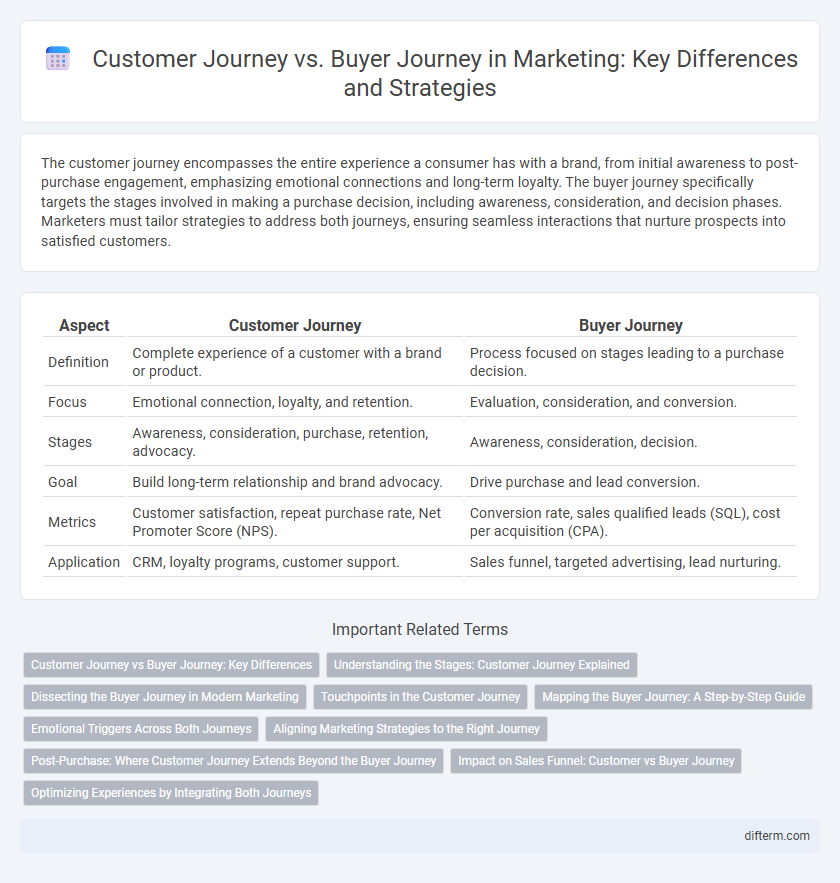The customer journey encompasses the entire experience a consumer has with a brand, from initial awareness to post-purchase engagement, emphasizing emotional connections and long-term loyalty. The buyer journey specifically targets the stages involved in making a purchase decision, including awareness, consideration, and decision phases. Marketers must tailor strategies to address both journeys, ensuring seamless interactions that nurture prospects into satisfied customers.
Table of Comparison
| Aspect | Customer Journey | Buyer Journey |
|---|---|---|
| Definition | Complete experience of a customer with a brand or product. | Process focused on stages leading to a purchase decision. |
| Focus | Emotional connection, loyalty, and retention. | Evaluation, consideration, and conversion. |
| Stages | Awareness, consideration, purchase, retention, advocacy. | Awareness, consideration, decision. |
| Goal | Build long-term relationship and brand advocacy. | Drive purchase and lead conversion. |
| Metrics | Customer satisfaction, repeat purchase rate, Net Promoter Score (NPS). | Conversion rate, sales qualified leads (SQL), cost per acquisition (CPA). |
| Application | CRM, loyalty programs, customer support. | Sales funnel, targeted advertising, lead nurturing. |
Customer Journey vs Buyer Journey: Key Differences
The customer journey encompasses every interaction between a consumer and a brand, from initial awareness to post-purchase engagement, while the buyer journey specifically focuses on the decision-making process leading to a purchase. Key differences include the customer journey's broader scope covering loyalty and retention, whereas the buyer journey centers on the evaluation and buying stages. Understanding these distinctions enables marketers to tailor strategies for acquisition, conversion, and long-term customer relationship management effectively.
Understanding the Stages: Customer Journey Explained
The customer journey encompasses every interaction a person has with a brand, from initial awareness to post-purchase engagement, while the buyer journey specifically focuses on the decision-making process leading to purchase. Key stages include awareness, consideration, decision, and retention, each requiring tailored marketing strategies to optimize customer experience and conversion rates. Mapping these stages helps businesses deliver relevant content and personalized communication, enhancing satisfaction and loyalty.
Dissecting the Buyer Journey in Modern Marketing
Dissecting the buyer journey in modern marketing reveals distinct phases: awareness, consideration, and decision, each requiring tailored strategies to engage potential customers effectively. Unlike the broader customer journey, which encompasses post-purchase experiences and brand loyalty, the buyer journey zeroes in on motivation and conversion triggers driving purchase behavior. Leveraging data analytics and personalized content during these stages enhances targeting precision, improving conversion rates and return on marketing investment.
Touchpoints in the Customer Journey
Touchpoints in the customer journey refer to all the interactions a customer has with a brand, from initial awareness to post-purchase engagement, shaping their overall experience and perception. Unlike the buyer journey, which focuses specifically on the decision-making process leading to a purchase, customer journey touchpoints encompass broader emotional and cognitive engagements across multiple channels. Optimizing these touchpoints enhances customer satisfaction, loyalty, and lifetime value by creating seamless, personalized brand interactions at every stage.
Mapping the Buyer Journey: A Step-by-Step Guide
Mapping the buyer journey requires identifying key touchpoints where potential customers interact with your brand, from awareness to decision-making stages. An effective step-by-step guide involves outlining buyer personas, charting their pain points, and aligning marketing messages to each phase: awareness, consideration, and purchase. Leveraging data analytics and customer feedback ensures the mapping reflects real behaviors, improving marketing strategies and conversion rates.
Emotional Triggers Across Both Journeys
Emotional triggers play a crucial role in both the customer journey and buyer journey by influencing decision-making and loyalty. Understanding emotions such as trust, excitement, and fear at each touchpoint enhances personalized marketing strategies and drives conversions. Mapping these emotional responses enables brands to create targeted content that resonates deeply and fosters long-term engagement.
Aligning Marketing Strategies to the Right Journey
Aligning marketing strategies to the customer journey rather than just the buyer journey enhances overall engagement by addressing every touchpoint from awareness to loyalty. The customer journey encompasses emotional and cognitive stages, whereas the buyer journey focuses primarily on purchase decisions, requiring distinct messaging and tactics. Effective marketing campaigns leverage data analytics and personalization to align content with each stage, optimizing conversion rates and long-term customer retention.
Post-Purchase: Where Customer Journey Extends Beyond the Buyer Journey
The customer journey extends beyond the buyer journey by encompassing the post-purchase phase, which includes customer support, product usage, and loyalty programs that drive repeat business and advocacy. Effective post-purchase engagement enhances customer satisfaction, encourages positive reviews, and boosts lifetime value, differentiating it from the more transactional focus of the buyer journey. Brands leveraging data-driven insights in this stage can optimize retention strategies and foster long-term relationships.
Impact on Sales Funnel: Customer vs Buyer Journey
The customer journey encompasses every interaction a prospect has with a brand, influencing awareness, consideration, and loyalty stages, thus shaping the entire sales funnel experience. The buyer journey specifically targets the decision-making process leading to a purchase, directly impacting conversion rates and sales funnel efficiency. Understanding the distinction allows marketers to tailor strategies that optimize engagement at each sales funnel stage, driving higher revenue growth.
Optimizing Experiences by Integrating Both Journeys
Optimizing marketing strategies requires integrating the customer journey and buyer journey to create seamless and personalized experiences. Mapping touchpoints across awareness, consideration, and decision stages ensures consistent messaging that addresses both emotional engagement and transactional intent. Leveraging data analytics and automation tools enhances targeting accuracy, driving higher conversion rates and long-term brand loyalty.
Customer journey vs buyer journey Infographic

 difterm.com
difterm.com